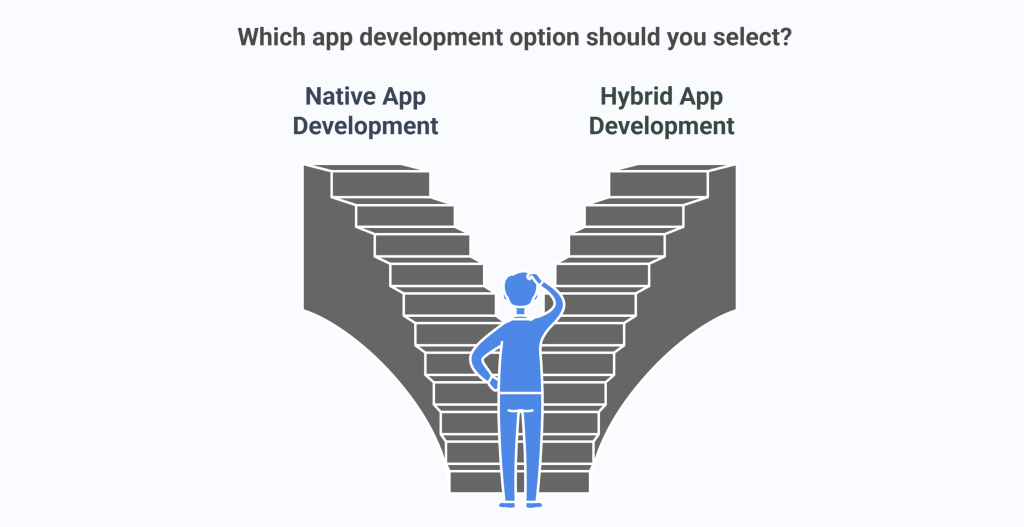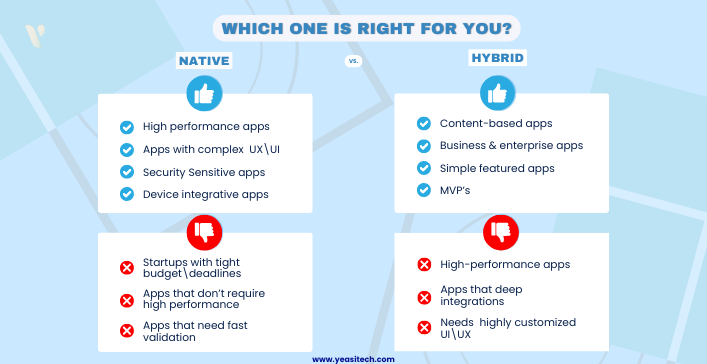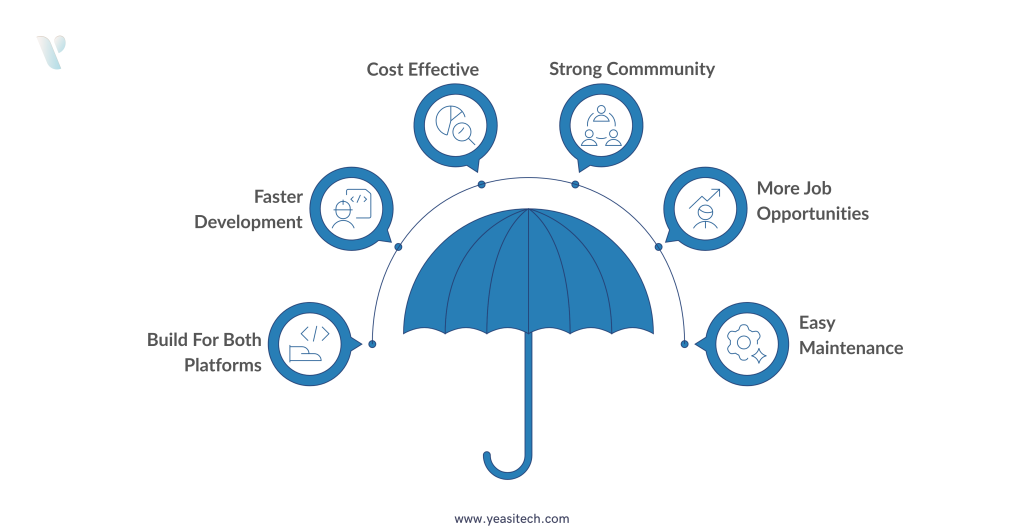Native vs Hybrid Mobile Apps: Hybrid Is the Smart Starter Choice in 2025

With a clear vision and strong passion, you’re ready to tackle challenges. But one key decision awaits: Native or Hybrid mobile app development? Selecting the appropriate strategy is essential in the constantly changing field of mobile app development, particularly for beginners. This choice shapes your project’s cost, timeline, and success. Understanding both paths will guide you through the app development journey.
By the end of this article, you’ll fully understand Native and Hybrid mobile app development, its complexities, pros and cons, performance, and resource needs, enabling you to make an informed choice.
Here is a comparison between Native and Hybrid Mobile Apps, highlighting their key differences in terms of technology, performance, development time, cost, and more:
| Feature | Native Mobile Apps | Hybrid Mobile Apps |
| Definition | Built specifically for a single platform (iOS or Android) using platform-specific languages. | Built using web technologies (HTML, CSS, JavaScript) and wrapped in a native container. |
| Technology Used | Swift, Objective-C (iOS); Kotlin, Java (Android) | Ionic, React Native, Flutter, Xamarin, Cordova |
| Performance | High performance, optimized for the platform | Slightly slower due to web view rendering |
| User Experience (UX) | Smooth, platform-specific UI/UX | UI may not feel as native as platform-specific apps |
| Access to Device Features | Full access to device hardware (camera, GPS, Bluetooth, sensors, etc.) | Limited access, requires plugins for native features |
| Development Time | Longer, as separate apps are built for each platform | Faster, as a single codebase works across multiple platforms |
| Development Cost | Higher, requires separate development teams for iOS & Android | Lower, single codebase reduces development effort |
| Maintenance | More complex, as separate updates are needed for each platform | Easier, as one update applies across all platforms |
| Offline Functionality | Works seamlessly offline | May require additional efforts for offline functionality |
| App Store Approval | May take longer due to platform-specific guidelines | Similar process, but approval depends on web technology compliance |
| Best for | Performance-heavy apps (gaming, AR/VR, fintech, etc.) | Simple apps, MVPs, and budget-conscious projects |

Native apps are built for iOS or Android using Swift or Kotlin. They offer great performance, a smooth user experience, and strong device integration but take more time and cost more to develop. Here’s why:
Best for:
Not ideal for:

Hybrid mobile app development lets you build apps for multiple platforms with one codebase. It combines native and web technologies, making development faster and cheaper. However, it also has challenges. Let’s look into the pros, cons, and real-world insights of hybrid mobile apps:
Best for:
When to Avoid Hybrid Apps:

Hybrid frameworks have seen massive adoption in recent years. A 2024 Stack Overflow survey reported that 42% of developers use React Native or Flutter for mobile app development.

You don’t have to study Objective-C, Kotlin, or Swift separately while using hybrid development. With only one set of skills, you can design apps for iOS and Android using JavaScript (React Native) or Dart (Flutter).
Hybrid frameworks offer hot reloading, which means you can see code changes instantly without restarting the app. This speeds up the development process and helps beginners debug easily.
It can be costly to hire several teams for iOS and Android. Hybrid frameworks are ideal for small businesses, freelancers, and startups because they require only one team to develop for both platforms.
React Native and Flutter have huge developer communities. There are many tutorials, open-source libraries, and forums available to assist you if you run into problems.
Book a free consultation with a YeasiTech expert and get top-notch advice regarding Hybrid Mobile App
Hybrid development is preferred by many businesses due to its speed and lower cost. Learning React Native or Flutter increases your chances of getting hired!
With one codebase, updates and bug fixes are much simpler. This is a huge advantage over native development, where separate updates are needed for iOS and Android.
Here are some real-life examples of successful hybrid mobile apps:
Technology: Uses React Native (initially a hybrid app).
Impact & Results:
This solution ensures a seamless iOS and Android experience with consistent performance. It enables offline access via cached data, keeping users connected. The app offers a smooth, interactive UI with native-like performance, boosting engagement. With 2+ billion users, its impact is vast.
Technology: Uses hybrid web technology (JavaScript-based).
Impact & Results:
Gmail offers fast, efficient email management and seamless integration with Google services, boosting productivity. With over 1.5 billion users, it’s one of the world’s most popular email platforms.
Technology: Uses a hybrid web framework (m.uber.com) for rider and driver apps.
Impact & Results:
Fast, scalable, and user-friendly. Seamless booking for 130M+ users worldwide.
Technology: Initially hybrid, then adopted React Native.
Impact & Results:
The platform offers a smooth, intuitive interface for travelers and hosts, scaling globally with millions of listings. It manages high engagement efficiently with real-time interactions for seamless experiences.
Fun Fact: Google is using Flutter for its next-generation apps, proving its reliability for big projects.
At YeasiTech, customers and prospective customers frequently ask us which option is best for them. We have hands-on experience in both native and hybrid mobile app development. We are able to offer a thorough analysis that surpasses theory because of our in-depth knowledge of the complexities, benefits, and drawbacks of each strategy. Regardless of whether they choose to engage with us or not, we have a track record of helping potential clients make well-informed decisions that support their objectives.

Choosing between Native and Hybrid app development impacts performance, cost, and scalability. Native apps excel in performance and user experience, while Hybrid apps offer affordability and faster development—ideal for startups.
With evolving frameworks like React Native and Flutter, Hybrid development is more efficient than ever, gaining traction as an industry standard in 2025 and beyond.
For beginners, Hybrid allows cross-platform development with one codebase. However, for top performance, security, or complex features, Native is the better choice.
Need help deciding? YeasiTech’s experts can guide you. Book a free consultation today to bring your app idea to life!
Native mobile apps are built specifically for a platform (iOS or Android) using languages like Swift or Kotlin. Hybrid mobile apps use web technologies (HTML, CSS, JavaScript) and run inside a native container, making them cross-platform.
Hybrid development is easier for beginners because it uses web development skills (HTML, CSS, JS), has a faster learning curve, and allows deployment on multiple platforms with a single codebase, reducing effort and cost
The top hybrid frameworks include Flutter, React Native, Ionic, and Capacitor, offering great performance, community support, and easy integration with native features.
Yes, modern hybrid frameworks like Flutter and React Native provide near-native performance with optimized UI rendering, making them a great choice even for demanding applications.
Hybrid development reduces costs by allowing developers to write one codebase for multiple platforms, cutting development time, maintenance costs, and the need for separate native developers.
YeasiTech is a trusted IT service partner with 8+ years of experience, empowering 250+ businesses with scalable web, mobile and AI solutions.
Explore related topics to broaden your understanding and gain actionable insights that can transform your strategies.